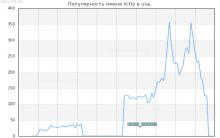
If you already have a guitar, now you need to tune it. Let's try to figure it out how to tune a guitar and how to do it correctly? Let's look at it in this lesson.
Any guitar needs tuning, even a new one. What can we say about the old one? After all, over time, the instrument becomes out of tune, even if you don’t play it. Therefore, let's look at how to tune a guitar in different ways.
The first thing we will start with is to try to configure the guitar online using the ready-made sounds that you see below:
1. First string (E)
2. Second string (H)
3. Third string (G)
4. Fourth string (D)
5. Fifth string (A)
6. Sixth string (E)
Everything is clear here - we tune each string from the 1st to the 6th. Naturally, you tune the strings open, that is, you don’t need to clamp anything anywhere. This method involves tuning the guitar by ear.
How to tune a guitar using a piano?
If you have a piano or upright piano at home, you can use it to tune your guitar. Look at the picture:

The picture above shows the piano keys corresponding to the guitar strings (the numbers are the guitar strings). For more information about string numbering, see here: “Placing hands on a guitar.” That's all, there is nothing complicated here.
Most people don't know what a tuner is and how to tune a guitar using a tuner
A tuner is a device for tuning a guitar. It can be used to tune both acoustic and electric guitars.
In order for a beginner to set up acoustic guitar using a tuner, the tuner has a microphone, and for electric guitar you need to use the line input for the instrument cable.
The tuner is shown in the figure:

The principle of operation of the tuner is as follows: You make the sound of a string on a guitar, and the tuner shows the note that corresponds to the frequency of vibration of the string. Usually the tuner shows letters, for example E, H, A, etc. Each letter corresponds to a string:
On the scale, see what needs to be done - lower the string (unwind b), or raise it (tighten #).
The advantage of tuning a guitar using a tuner is that you may have absolutely no hearing, because the tuner does everything for you. This is very helpful for beginners in tuning their guitar. In addition, there are tuners that easily fit in your pocket and you can always carry it with you, for example in a guitar case.
How to tune a guitar using a tuning fork?
A tuning fork is a special instrument for tuning a guitar, which has a shape similar to a fork. The tuning fork is shown in the figure:

Tuning a guitar with a tuning fork is a little more difficult than tuning with a tuner. Here you will need a little hearing. This method can be called "tuning the guitar by ear", but don't be alarmed. This method is as follows. The tuning fork makes only one sound (“la”, frequency 440 Hz). The first string of your guitar, at the fifth fret, should have exactly this “A” sound. Tune the 5th fret of the 1st string so that it sounds in unison with the tuning fork. So, we have the first string tuned;
- Now, to tune the second string, fret it at the fifth fret, and tune it so that it sounds in unison with (the same as) the first open string;
- the third string on the fourth fret sounds in unison with the second open;
- the fourth string at the fifth fret corresponds to the third open;
- the fifth on the fifth fret sounds in unison with the open fourth;
- and the sixth string at the fifth fret is the same as the fifth open string.
OK it's all over Now. The guitar is tuned. Once again, to tune a guitar for a beginner using this method, you will need to have hearing, but this does not mean that a beginner cannot tune a guitar using a tuning fork.
Correct setting six string guitar
"Tutorial" Guitar lesson No. 3
Many sites on the Internet outline how to properly tune a guitar for a beginner, but nowhere is there a detailed description of the correct tuning of a guitar. It is difficult for a beginner to correctly tune a guitar using only tuning diagrams. I myself started as a self-taught person and therefore I can describe this process in more detail.. Before tuning a guitar, a beginner should know two such concepts as unison and fret, since the correct tuning of a guitar is based on the unison of sounds on certain strings and frets of the guitar.
1. Unison translated from Latin means monotony. This means that two sounds that sound the same in pitch will be unison. (Two strings together sound like one.)
2. Fret has a broader concept, but we will consider the concept of fret in relation to the guitar neck. Frets are transverse metal inserts on the neck of the guitar (their other name is frets). The spaces between these inserts where we press the strings are also called frets. Frets are counted from the headstock of the guitar and are designated by Roman numerals: I II III IV V VI, etc.
And so we move on to the question of how to properly tune the first string of a guitar. The first string is the thinnest string. A beginner should know that when the string is tensioned, the sound increases, and when it is loosened, the sound decreases. If the strings are loosely tensioned, the guitar will sound flabby; overtightened strings may not withstand the tension and burst. Therefore, the first string is usually tuned using a tuning fork pressed on the fifth fret of the fingerboard; it should sound in unison with the sound of the tuning fork “A” (A of the first octave). A home telephone can also help you tune your guitar (the beep in its receiver is slightly lower than the sound of a tuning fork), you can also go to the section where the sound of the open strings of a six-string guitar is presented.
Tuning the first string of a guitar
It is advisable to loosen the first string before tuning, since our hearing is more receptive when the string is tense than when it is overtightened and must be lowered when tuning. First, we listen to the sound by which we tune the guitar and only then press it on the V fret, strike it and listen to the sound of the string. Follow these tips when tuning the next strings. So, having achieved unison and tuning the first string, we move on to the second.
Tuning the second string of a guitar
The first open (not pressed) string should sound in unison with the second string pressed also at the V fret. We stretch the second string to unison by first striking and listening to the open first string, and only then the second string pressed on the V fret. For a little control, after tuning the second string, hold it down at the fifth fret and hit the first open string and the second down string at the same time. If you hear only one clear sound similar to the sound of one, and not two strings, then proceed to tuning the third string.
Tuning the third string of a guitar
The third string is the only one that is tuned pressed to the 4th fret. It is tuned to the second open string. The process remains the same as when tuning the second string. We press the third string at the fourth fret and pull it in unison open second strings. After tuning the third string, you can check it - pressed at the IX fret, it should sound in unison with the first string.
Tuning the fourth guitar string
The fourth string is tuned to the third. The fourth string pressed at the V fret should sound like an open third string. After tuning, the fourth string can be checked - pressed at the IX fret, it should sound in unison with the second string.
Fifth string tuning
The fifth string is tuned to the fourth. The fifth string pressed at the V fret should sound like the fourth open string. After tuning, you can check the fifth string - pressed at the X fret, it should sound in unison with the third string.
Tuning the sixth string of a guitar
The sixth string is tuned to the fifth. The sixth string pressed at the V fret should sound like an open fifth string. After tuning, you can check the sixth string - pressed at the X fret, it should sound in unison with the fourth string.
So:
The 1st string (E), pressed at the V fret, sounds like a tuning fork.
The 2nd string (B), pressed down at the V fret, sounds like the first string open.
The 3rd string (G), pressed at the 4th fret, sounds like an open second.
The 4th string (D), pressed down at the 5th fret, sounds like an open third.
The 5th string (A), pressed at the V fret, sounds like an open fourth.
The 6th string (E), pressed down at the V fret, sounds like an open fifth.
Greetings, dear friend! I can congratulate you if you have become the happy owner. Your dream has come true, you have this cool thing at home and you dream of surprising all your friends and acquaintances, and maybe your girlfriend, with some cool song.
But all these are still plans for the future, which will definitely come true when you learn to play the guitar, and this will be very soon, believe me. If you are serious about becoming a great maestro and conquering women's hearts, and maybe even the stage with your talent, then you need to gradually, step by step, develop your playing technique and replenish your knowledge with new and new material.
Since you have landed on this page, you will definitely need my help. And since this article is called “How to properly tune an acoustic guitar?”, this is exactly what we will talk about next. Believe me, not only you, but also many beginners have problems tuning the guitar. After studying this material, you will learn:
- How to learn how to quickly and easily tune a guitar by ear?
- How to perfectly tune a guitar through a computer and a tuner at home?
I will answer all these questions in this article. So get your guitar ready, sit back and get into it.
How did I learn?
Unfortunately, not many people have ear for music. In this regard, it was somehow easier for me when I got my first guitar, and I was just starting to learn how to play it. Maybe this was somehow inherited, because my family consists of almost only musicians. I learned how to tune a guitar quickly, since it didn’t seem that difficult to me from the very beginning.
Now I can easily tune my guitar by ear and can do without any tuners. But if I need to record something on a computer, then I can still use the help of a guitar tuner to more accurately (tightly, so to speak) make the settings. So today I want to look at two ways to tune a guitar, so to speak " aurally" And " using a tuner».
How to tune a guitar by ear?
Since I’m not a fan of looking for easy ways, I’ll now tell you about the first method of tuning, which will stick in your head for the rest of your life. You need to be able to tune by ear first, and then get acquainted with all sorts of tuners. This is an old method that will always come in handy even when traveling, and will never let you down, because even if you string the strings on a bare guitar, you can easily tune it in 5-10 minutes.
I’ll say right away that we will be tuning the guitar in standard classical (“Spanish”) system E(Mi). Here is the table of the classic standard tuning guitars for orientation.


Classic tuning method (5th fret)
This method is considered the most popular and widespread among beginners because of its clarity and relative simplicity. So first of all we need to know how to tune 1 string?
- String No. 1(the thinnest without winding, which is at the bottom). The most important thing is that the tuning of the entire guitar begins with it. It is tuned by note E(E) of the first octave. You can take the sound of another already tuned instrument as a standard (a piano or some program on a PC or smartphone is ideal).

The note E can be recognized by the dial tone on your telephone. You can also use a tuning fork for greater accuracy.

Fork- this is a portable small device in the form of a whistle tube (maybe even in the form of a keychain), which clearly reproduces the note A(La). By holding string No. 1 at the 5th fret, we get A, and in the open state it is E.

- String No. 2. This string will be tuned based on the first one. That is, the second string must be clamped at the 5th fret and tuned so that it sounds in unison (the same) with the first open (not clamped) E string.
- String No. 3. This is the only string that is tuned when pressed, not at the 5th fret, like all the others, but at the 4th fret. That is, we clamp the third string at the 4th fret and tune it in unison with the second open one.
- String No. 4. Here we again need to press the string at the 5th fret so that it sounds like an open third. Further, even easier.
- String No. 5. We tune the fifth string in the same way - press it to the 5th fret and turn the peg until we achieve unison with the fourth string.
- String No. 6(the thickest one is in the winding, which is at the top). We tune it according to the same scheme - press it on the 5th fret and make unison with the fifth string. The sixth string will sound the same as the first, only with a difference of 2 octaves.

After you have tuned all the strings in turn, I recommend going through them again and making a small adjustment, since some strings may weaken and become a little out of tune due to the tension of others. This must be done until all the strings sound in unison. After this, your guitar will be almost perfectly tuned.
You can tune a six-string acoustic guitar more accurately and correctly using harmonics, since sometimes it is not always enough to tune it by frets. Flajolet- this is a technique when you need to lightly touch (not squeeze) the strings with your finger in the middle of the fret and extract the sound right hand and at this moment remove your finger from the string. The setup sequence here will be slightly different.

- String No. 1. The first string in this case is tuned, just like in the classic way, i.e. by the sound of another properly tuned instrument.
- String No. 6. The sixth is the thickest string, which is tuned with a harmonic at the 5th fret in unison with first open string.
- String No. 5. The fifth string should be tuned so that the harmonic at the 7th fret sounds the same as first open string.
- String No. 4. Tighten the 4th string until the 7th fret harmonic is in tune with the 5th fret harmonic.
- String No. 3. We tune the third string so that the harmonic at the 7th fret sounds in unison with the harmonic fourth string, taken at the 5th fret.
- String No. 2. Tune the second string so that the harmonic on the 5th fret sounds in unison with the harmonic on the first string, taken on the 7th fret.
How to tune a guitar using a tuner?
You can almost perfectly tune a guitar quite simply either through a computer (for example, from Mooseland or in the program), or using a regular electronic portable tuner, since this is the most easy way instrument settings. If you don’t have it installed on an acoustic guitar, then you can use a regular microphone, which, I think, will definitely be at hand.

To do this, the microphone (or pickup, if any) must be connected to a regular tuner or to a virtual one on the computer. If it is a tuner like the one shown in the image above, then fix it on the headstock - vibrations from the strings will be transmitted to the tuner.
Everything is quite simple here! All you have to do is pull the string (for example, it will be 1st) and tune it until the letter appears on the display E, i.e. note E. If it is a tuner with an arrow, then it (the arrow) should be in the center. This will indicate that the setup is correct. Similar actions must also be performed with the rest. This will be the most accurate and quick way settings.
How to check the tuning of a guitar?
Feature of all string instruments, including an acoustic guitar, is that it is quite difficult to tune it perfectly. This is mainly due to the design features of the instrument itself, as well as to the sound production technique. After properly tuning the strings in the classical way, there is still no guarantee that the guitar will play 100% well overall. Some chords may not sound quite clear. It’s not that the guitars there are of poor quality or bad, but even new and good tools They don't always build perfectly. That's why all guitarists try to periodically carefully check and tune their guitar using various techniques.

The easiest way- This is tuning the guitar according to chords. After some time, when you gain more experience, and your hearing becomes more developed and is sensitive to any falseness, then you will only need to play any chord on the guitar and determine which string is out of tune. Once you determine which string needs tuning, you can easily fix it with a peg. After this, a few more chord checks and adjustments will be required. As a result, you will achieve the desired result and optimal guitar tuning.
In conclusion, I would like to say this. Be sure to check the sound of the first and sixth open strings. The sound from them must be extracted simultaneously - it must merge and be smooth, and it will be heard that the sound consists of two voices - high and low.
I guess that's all for today, dear friend! I hope this article helped solve your problem, and now you already know how to properly tune a six-string acoustic guitar quickly and easily. Write in the comments how quickly you were able to tune your guitar? If you have a friend who is also learning to play, send him this article, I will be very grateful to you. I hope this way I can help other people. Yes, and finally, be sure to watch the video tutorials on how to tune a guitar right below the article, I recommend it.
A guide to tuning your guitar by hand. Fifth fret method. This article suggests tuning a guitar by ear using the “fifth fret” method. This method for tuning a six-string guitar is probably the most popular and ancient method of tuning this instrument. We offer you a tuning diagram and its musical expression. As well as a detailed verbal description of this method.
How to tune a guitar by ear using the “fifth fret” method. Preparatory exercise for beginners.
To learn how to tune a guitar manually by ear in general and with this method in particular, use your auditory experience when playing two-syllable words.
Extract two sounds from the thinnest (first) string of the guitar. Now for each of the two hits on this unpressed string, say two syllables (“mi” - “mo”). Try to make the sounds of your voice and strings become the same, merge, and become the same in height. Listen carefully to these sounds. Please note that these sounds are the same in pitch. They can be of different volumes, timbres and durations, but their pitch is the same.
Next, play the first note on the first string of the guitar, and the second note on the second string, pressed with your left hand at the fifth fret. They should sound the same (they also say - in unison). To do this, rotate the peg of the second string until the sound of these sounds completely coincides.
Guitar tuning. Advice
To keep your guitar in tune longer, follow these steps.
Loosen the tuning string. Then pull it up to the desired height. Pull it a little higher. And then lower it back to the desired height.
After this preparatory exercise, let's start tuning with the first string. We remind you that the first string is the thinnest string of the guitar.
How to tune a guitar by ear using the “fifth fret” method. Guitar Tuning
1. The first string, pressed to the V fret, is tuned using a tuning fork* for the 1st octave. The pitch of the string is compared with the tuning fork until they completely coincide. For these purposes, use the first one from the given link. The second will help you check the tuning by looking at the unpressed (open) strings of the instrument.
2. After this, we tune the second string. It should sound the same at the V fret with the open (unpressed) first string.
3. The third string, pressed, note, on the 4th fret, should sound in unison (the same) with the open second.
4. The fourth, pressed again at the V fret, with the third open.
5. The fifth on the V fret - with the fourth unpressed.
6. The 6th is on the V fret with the 5th string open.
Let's summarize all this in a diagram.

Tuning a six-string guitar using the “fifth fret” method. Scheme
For lovers musical notation We offer the same scheme, only in notes.

Tuning a six-string guitar using the “fifth fret” method. Staff
Practice tuning your six-string guitar by detuning it first.
We looked at the tuning of a six-string guitar in standard E tuning. There are other guitar tunings in which the relationship between the strings may differ significantly from the one considered. However, the very described principle Tuning a guitar by ear works in any situation and any tuning of the instrument. I suggest alternative way six-string guitar settings - see.
*Fork- this is the standard of pitch, most often the sound “A” of the first octave (440 Hz). Most often there are two types: fork and wind (in the form of a whistle).
If you do not have a tuning fork, then you can use any other instrument as a sound standard: piano, harmonica, another guitar, accordion, or any other instrument. If there is no instrument nearby, then tune the first string by eye - check whether it is tensioned enough according to the sensations of your fingers. This adjustment “by eye” is called relative(without reference to the exact height of the reference sound). A guitar tuned in relative tuning can be played solo (without involving other instruments) or accompanied by a voice.
How to tune a guitar for a beginner?
You have decided to devote some of your precious time to an activity like music. Commendable. Music is an absolutely unique matter, woven from the thoughts of the musician and the wave vibrations of the sound of the instrument. Playing on any of musical instruments, a person is immersed in the world bright colors and images, coming out of which, he forever falls in love with this word. The word "music". In this article we will talk about playing the guitar, and we will start with the first stage - tuning the instrument.
Any instrument should sound coherent and good. Correct tuning allows the musician to merge even more fully with the harmony and rhythm coming out of his hands through the strings of the guitar.
Let's assume you are a beginner. You probably already know a couple of chords that you really want to hear performed yourself. But you need to start by setting up your instrument. So, how to tune a guitar for a beginner?
Guitar tuning
Any musician or performer, whether a beginner or a master, tunes a guitar according to one pattern. The only difference between a beginner and a professional is the ability to hear and determine the desired tone of sound. The procedure for manually tuning a guitar is as follows:
- Look at the neck of the guitar - you will see six strings there. You should start tuning with the lowest string, which is also considered the first. This is the thinnest string and its sound corresponds to the note E (E) of the first octave.
- Use your finger or pick to pluck the first string. Unless you accidentally interrupt the sound, you will hear the note E. How do we check if it actually sounds the right note? Everyday method: call somewhere where they won’t answer the phone or ask someone not to answer. The beeps you hear correspond to the note E. Now that you have memorized the sound, you can tighten or loosen the string in order to get the note E.
- In order to adjust the tone of the strings, guitar pegs are used. They are located on the head of the guitar. If your guitar is made in such a way that you see three pegs on each side of the head, then you have in your hands classical guitar. The first string is the peg closest to the fingerboard. The strings are connected to pegs, so you can trace that connection and find the right peg to tune the instrument.
- So. The pin has been found. Now pluck the string. And while the note sounds, try to turn the peg different sides. You will probably notice that your actions change the pitch of the sound. Your task is to build the first string so that it sounds like the note E. In addition to a regular telephone, you can use a special device. It's called a tuning fork. The tuning fork produces the note of each string. By ear you can line up each string.
- Let's assume that you have achieved the desired sound of the first string. And you hear the beautiful, light and airy note of E. From this string you can build the entire guitar. How to tune your guitar next. Let's do it as follows.
- Pluck the "open" first string. Open string- this means that you do not pinch the string on any of the guitar frets.
- Now pinch the second string (this is the next thickest and in order after the first) at the fifth fret. The construction technology is as follows. The open first string and the second string clamped at the fifth fret should sound exactly the same. Now, using the second string peg, you need to achieve the correct sound. We achieved it. Let's move on to the third string.
- The third string, clamped at the fourth fret, should sound the same as the open second. Set up.
- The fourth string, clamped at the fifth fret, should sound the same as the open third.
- The fifth string, clamped at the fifth fret, should sound the same as the open fourth.
- Finally, the 6th string held at the 5th fret should sound the same as the 5th string open.
- Now you need to check the system. Play any chord you know. If it sounds clean and without falsehood, then the guitar is built correctly.
This manual method settings. You can also use a tuner. You need to buy it. How to tune a guitar for a beginner using a tuner? The instructions clearly explain the principles of its operation and how to build a guitar with its help.











The benefits of sunflower seeds for the heart, hair and nerves
Why do my legs give way at the knees?
Name energy: how the patronymic influences fate and the birth program Name patronymic meaning character
First Chinese Emperor
Alfred the Great: biography